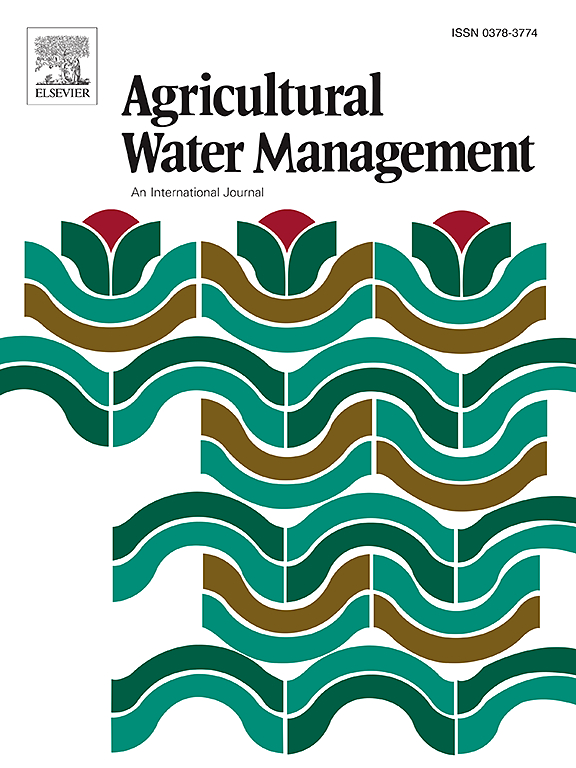Optimizing irrigation amount and salinity level for sustainable cotton production and soil health
IF 5.9
1区 农林科学
Q1 AGRONOMY
引用次数: 0
Abstract
Brackish water is usually abundant and regarded as potential irrigation water resource in arid regions such as Xinjiang Province, China. However, although brackish water can alleviate water stress for crop growth, it may bring salt into soil, resulting in potential threats of soil secondary salinization and crop salt stress. To use the brackish water safely and effectively, experiments were conducted in 2023 and 2024 to explore the impact of brackish water quantity and quality on the soil salt spatiotemporal distribution, cotton growth and yield in the film mulched drip irrigation fields in Southern Xinjiang. It includes three irrigation amounts (W1: 75 % I, W2: 100 % I and W3: 125 % I, where I is crop irrigation water requirement) and three irrigation salinities (S1: 1.5 g/L, S2: 3.5 g/L and S3: 5.5 g/L). Results show that under excessive irrigation (W3), higher irrigation water salinity would limit the root water uptake, and result in higher soil water content in the root zone. A single deficit irrigation with brackish water at 3.5 g/L showed no significant difference in soil salt distribution before and after irrigation, but increasing irrigation amount was beneficial for mitigating soil salt accumulation in the root zone under the film. Under sufficient irrigation, 5.5 g/L saline water irrigation also caused salt accumulation in the deep soil beneath the film and the bare soil between the films around the wetting front. Compared with deficit irrigation, increasing irrigation amount with 5.5 g/L saline water neither promote cotton growth, nor significantly inhibit it. Higher irrigation salinity lead to a significant decline in cotton yield, but the effect of salt stress was mitigated under water deficit condition. Considering soil salt accumulation in the root zone under the film, cotton yield and water productivity (WP), the optimal irrigation amounts were 1.25 I for freshwater irrigation at 1.5 g/L, 1.35 I for brackish water irrigation at 3.5 g/L, and 1.06 I for saline water irrigation at 5.5 g/L. Our research provides guidance for the rational use of irrigation with different salinities and the sustainable development of irrigated agriculture in arid and semi-arid regions.
棉花可持续生产和土壤健康的优化灌溉量和盐度水平
在中国新疆等干旱地区,微咸水通常储量丰富,是潜在的灌溉水资源。然而,微咸水虽然可以缓解作物生长的水分胁迫,但也可能将盐分带入土壤,造成土壤次生盐碱化和作物盐胁迫的潜在威胁。为安全有效地利用微咸水,于2023年和2024年在南疆地膜滴灌农田进行了微咸水数量和质量对土壤盐分时空分布、棉花生长和产量的影响试验。它包括三个灌溉量(W1: 75 % I, W2: 100 % I和W3: 125 % I,其中I为作物灌溉需水量)和三个灌溉盐度(S1: 1.5 g/L, S2: 3.5 g/L和S3: 5.5 g/L)。结果表明,在过量灌溉(W3)条件下,较高的灌溉水盐度会限制根系对水分的吸收,导致根区土壤含水量升高。3.5 g/L微咸水单亏灌前后土壤盐分分布无显著差异,但增加灌水量有利于缓解膜下根区土壤盐分积累。在灌溉充足的情况下,5.5 g/L的盐水灌溉也会导致膜下深层土壤和湿润锋周围膜间裸露土壤的盐分积累。与亏缺灌溉相比,增加5.5 g/L盐水灌水量既不促进棉花生长,也不显著抑制棉花生长。高灌溉盐度导致棉花产量显著下降,但在水分亏缺条件下,盐胁迫的影响有所缓解。综合考虑膜下根区土壤盐分积累、棉花产量和水分生产力(WP),最佳灌水量为:1.5 g/L淡水灌1.25 I、3.5 g/L微咸水灌1.35 I、5.5 g/L盐水灌1.06 I。本研究为干旱半干旱区合理利用不同盐碱度灌溉和灌溉农业的可持续发展提供指导。
本文章由计算机程序翻译,如有差异,请以英文原文为准。
求助全文
约1分钟内获得全文
求助全文
来源期刊

Agricultural Water Management
农林科学-农艺学
CiteScore
12.10
自引率
14.90%
发文量
648
审稿时长
4.9 months
期刊介绍:
Agricultural Water Management publishes papers of international significance relating to the science, economics, and policy of agricultural water management. In all cases, manuscripts must address implications and provide insight regarding agricultural water management.
 求助内容:
求助内容: 应助结果提醒方式:
应助结果提醒方式:


